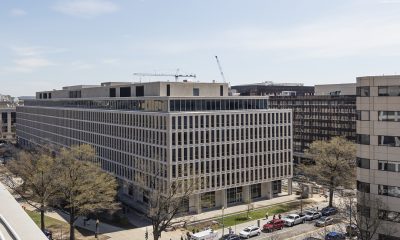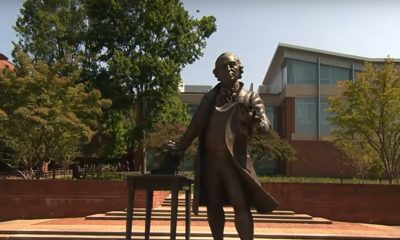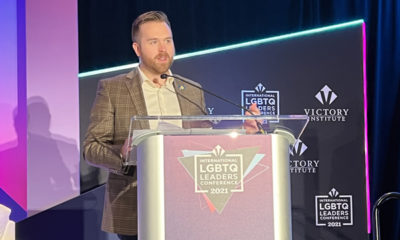Local
Catholic University LGBTQ student group remains unrecognized
CUAllies formed in 2009
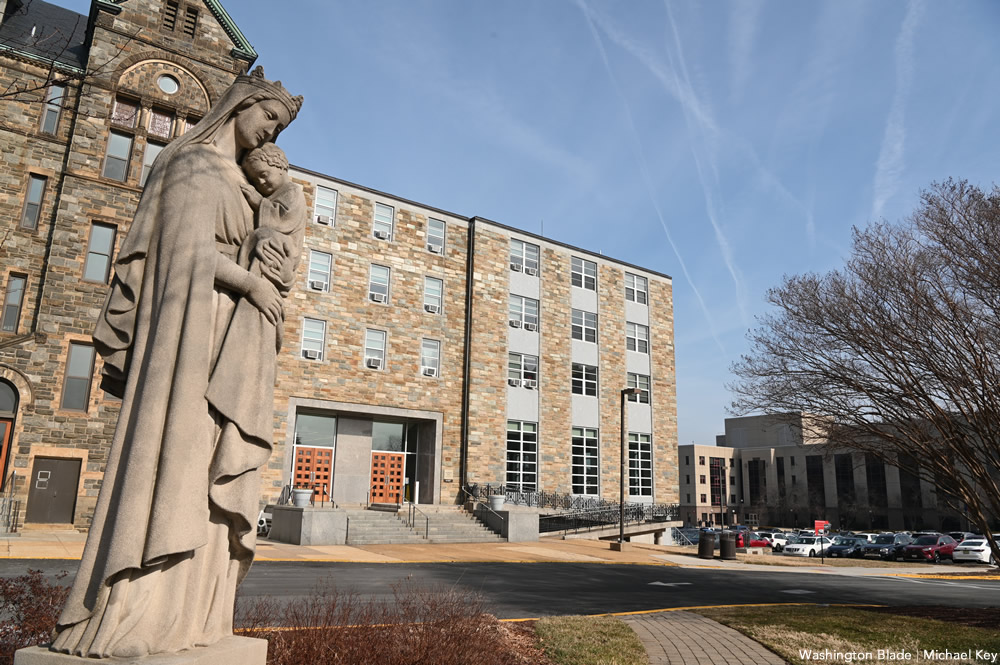
The only on-campus queer student organization at the Catholic University of America, CUAllies, is still fighting for official recognition.
Despite operating “underground,” the club’s roughly 10 members meet regularly to talk about issues facing LGBTQ college students, to create friendships and to connect LGBTQ students and allies with one another. Since the formation of CUAllies in 2009, the administration at Catholic University, most notably President John Garvey, has denied the club official recognition multiple times.
“Just the act of having the university recognize us would be a huge step because it would make people feel way more welcome,” said CUAllies President Ash Samuels. “The nature of having a club that operates under the radar makes you feel like they have to operate under the radar and so just being recognized would make people feel a lot more welcome.”
Additionally, without recognition CUAllies does not have access to the same resources as official student organizations. For example, they cannot rent rooms on campus for meetings, receive funding for events, and are prohibited from advertising club meetings or events on fliers on campus. According to Samuels, the club uses space at the Center for Cultural Engagement, where Director Javier Bustamante allows the club to meet and advertise events.
According to Samuels, CUAllies has been advised by the Dean’s Office to wait until next year to reapply when a new university president will replace Garvey. Until then, Samuels said the group still plans to hold meetings in-person, and he hopes to bring in speakers to talk to members about mental health and issues facing LGBTQ college students.
The last attempt by CUAllies to gain recognition was in March 2021, when the Catholic University’s Student Government Association passed a resolution after hours of public comment from students to support a resolution for the club to request official status. The request, however, was denied by Garvey.
“It was an interesting SGA meeting,” said Samuels. “A lot of people came to public comment and spoke their minds. There was a lot of homophobia.”
Catholic University is one of the 180 campuses deemed unsafe for LGBTQ youth on Campus Pride’s “Worst List.” Campus Pride, an organization that advocates for safe and inclusive college campuses for LGBTQ students, stated on their website that “Catholic University of America has qualified for the Worst Life because it has an extensive and well-documented history of anti-LGBTQ discrimination.”
In addition to repeatedly depriving LGBTQ students of the right to have an official student club, the university has also displayed its homophobic ideology by filing an amicus brief in the 2019 U.S. Supreme Court case Bostock v. Clayton County. In the brief, the university argued that the campuses should be allowed to discriminate based on sexual orientation or gender identity under the Civil Rights Act of 1964.
“This campus has repeatedly proven that they do not support LGBTQ rights, LGBTQ equality,” said Campus Pride Executive Director Shane Windmeyer.
A 2021 survey by the Religious Exemption Accountability Project, an organization that promotes equity for LGBTQ college students at Christian colleges, said that students at Christian colleges are 15 times more likely to report that their gender or sexual identity has prevented them from being accepted by others on campus compared to LGBTQ students at non-Christian colleges.
The pandemic has increased this sense of isolation, as students were forced to attend classes online and did not have access to the same social networks that were once offered in person on many campuses. Although mental health struggles have increased overall for college students overall throughout the pandemic, research has shown that LGBTQ individuals were more likely to have struggled with depression, anxiety, or suicidal thoughts than people identifying as straight.
Attending a university that already has limited resources for its LGBTQ student population, combined with the isolating effects of the pandemic, makes the Catholic University increasingly worrisome for LGBTQ students from a mental health perspective.
“It is a pretty awful environment from the standpoint of mental health if your campus did not have inclusion or had limited inclusion for LGBTQ policies, programs, or practices before the pandemic, the pandemic has only worsened that because of the isolation that these students feel,” said Windmeyer.
Samuels said that CUAllies has served as an important place for students at the Catholic University to meet other queer students, with many members making their first contact with other LGBTQ students through the club. However, Samuels said that operating remotely during the pandemic made it difficult to feel the same level of connection, despite the fact that the group was still meeting routinely over Zoom.
“The feeling of isolation is amplified for LGBTQ students, especially on this campus,” said Samuels. “You might not have friends who you are out to or you might not have friends at all. If you don’t have [club meetings] in person in order to make those connections, and you are already isolated, it makes it a lot harder.”
Despite not having an officially recognized LGBTQ student organization, the Catholic University offers groups orientated towards LGBTQ students through its Counseling Center and Campus Ministry.
The Counseling Center runs a weekly therapy group called MOSAIC, which “provides an environment where LGBT-identified and straight students can come together to learn about available resources, discuss various topics related to personal wellness, and build a supportive network with other students,” according to the Counseling Center’s webpage.
Samuels, who is an active participant in MOSAIC, said that both the therapy group and the Counseling Center are “very LGBTQ+ friendly.” Samuels said he routinely encourages members of CUAllies to get connected with the Counseling Center during club meetings.
According to Samuels, therapists at the Counseling Center have told him that they often get students who identify as LGBTQ, but are hesitant to join CUAllies because they are perceived as being “too liberal or not Catholic enough” despite the organization not having any political or religious affiliation and being welcoming to people of all backgrounds.
Additionally, Catholic University’s Campus Ministry offers a faith group called ‘Beyond the Labels’ which defines itself as a ministry for LGBTQ students “to support each other in their Catholic Christian life by forming holistic friendships,” according to Campus Ministry’s website.
The group was formed last fall by Father Jude DeAngelo, director of Campus Ministry.
“Because we are a Catholic school I think there is a population of students who are trying to integrate their faith with all the different labels that they have either chosen or that people put on them,” said DeAngelo to the Washington Blade. “I just want to have a place where students can come and they can be themselves and they can talk about their faith and their struggles to be Catholic Christians.”
On “Beyond the Labels,” Samuels said, “I think [DeAngelo] has the right intentions, but it still has that risk that people could turn it into a negative thing or misconstrued his words.”
Samuels said that leadership at CUAllies has expressed their concerns to the Counseling Center that “Beyond the Labels” could be potentially harmful towards LGBTQ students. Samuels said that he encourages people who are in need to seek out the Counseling Center first.
DeAngelo did not offer a comment to the Blade on whether he believed CUAllies should be officially recognized by the university, however, according to Samuels, DeAngelo has been an advocate for CUAllies to be officially recognized by the university.
Windmeyer said what the Catholic University has done with its ministry has been replicated at other campuses with harmful policies against LGBTQ students as a push to better their public image.
He said that these colleges try to, “create a narrative that shows that [they] are compassionate, that [they] recognize, underneath our ministry, our LGBTQ group, but [they] are not going to recognize them as student organizations, they have to do it through the ministry. That in itself is just telling me that they are just doing enough to pacify their students, they do not see Catholicism as giving LGBTQ people the human dignity and worth that they deserve.”
Windmeyer noted that other Catholic Universities, such as the University of Notre Dame — which has an official LGBTQ student organization — have made improvements throughout the years to be more inclusive of their LGBTQ student population.
The Catholic Church’s stance on LGBTQ-related issues has improved as well. Last year Pope Francis stated that he endorsed civil unions. However, despite these advancements, activists in conversation with the Blade have remarked church teachings on homosexuality and gender identity remain largely unchanged.
Samuels said that he hopes that the LGBTQ faith group run by DeAngelo will be a step to help the university advocate for CUAllies to become recognized. DeAngelo expressed that he is interested in getting more members of CUAllies involved with “Beyond the Labels,” specifically, he said wants to create joint day-retreat programs with the club.
In the past, “Beyond the Labels” partnered with CUAllies on a day retreat focused on forgiveness. Samuels, who was not a member of CUAllies during the forgiveness retreat, said that he would be more interested in partnering on a team-building retreat instead of focusing on forgiveness because many of CUAllies members are not Catholic.
“I am hopeful that it will lead him to be a larger advocate for us to be a club in the future, but I do also worry that they will just say ‘oh look we already have this program we don’t need you guys,’” said Samuels.
Catholic University did not return the Blade’s request for comment for this story.
District of Columbia
Catching up with the asexuals and aromantics of D.C.
Exploring identity and finding community
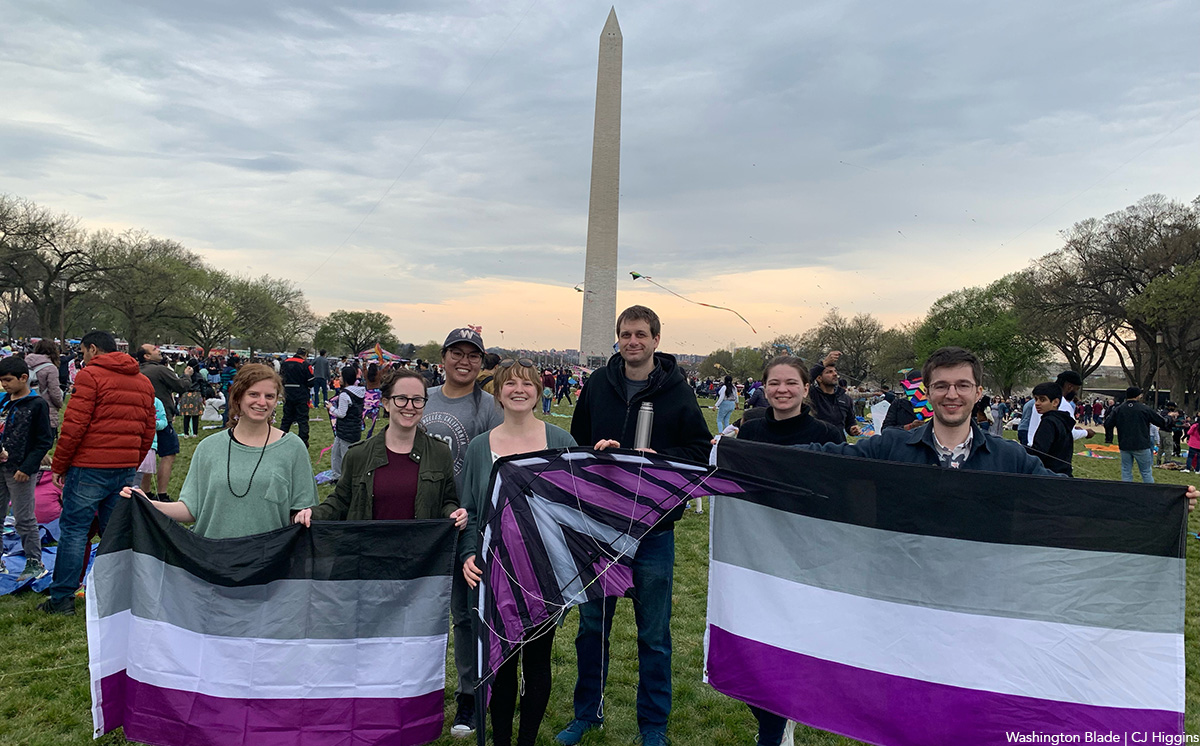
There was enough commotion in the sky at the Blossom Kite Festival that bees might have been pollinating the Washington Monument. I despaired of quickly finding the Asexuals and Aromantics of the Mid-Atlantic—I couldn’t make out a single asexual flag among the kites up above. I thought to myself that if it had been the Homosexuals of the Mid-Atlantic I would’ve had my gaydar to rely on. Was there even such a thing as ace-dar?
As it turned out, the asexual kite the group had meant to fly was a little too pesky to pilot. “Have you ever used a stunt kite?” Bonnie, the event organizer asked me. “I bought one. It looked really cool. But I can’t make it work.” She sighed. “I can’t get the thing six feet off the ground.” The group hardly seemed to care. There was caramel popcorn and cookies, board games and head massages, a game of charades with more than its fair share of Pokémon. The kites up above might as well have been a coincidental sideshow. Nearly two dozen folks filtered in and out of the picnic throughout the course of the day.
But I counted myself lucky that Bonnie picked me out of the crowd. If there’s such a thing as ace-dar, it eludes asexuals too. The online forum for all matters asexual, AVEN, or the Asexual Visibility and Education Network, is filled with laments: “I don’t think it’s possible.” “Dude, I wish I had an ace-dar.” “If it exists, I don’t have it.” “I think this is just like a broken clock is right twice a day type thing.” What seems to be a more common experience is meeting someone you just click with—only to find out later that they’re asexual. A few of the folks I met described how close childhood friends of theirs likewise came out in adulthood, a phenomenon that will be familiar to many queer people. But it is all the more astounding for asexuals to find each other this way, given that asexual people constitute 1.7% of sexual minorities in America, and so merely .1% of the population at large.
To help other asexuals identify you out in the world, some folks wear a black ring on their middle finger, much as an earring on the right ear used to signify homosexuality in a less welcoming era. The only problem? The swinger community—with its definite non-asexuality—has also adopted the signal. “It’s still a thing,” said Emily Karp. “So some people wear their ace rings just to the ace meet-ups.” Karp has been the primary coordinator for the Asexuals and Aromantics of the Mid-Atlantic (AAMA) since 2021, and a member of the meet-up for a decade. She clicked with the group immediately. After showing up for a Fourth of July potluck in the mid-afternoon, she ended up staying past midnight. “We played Cards against Humanity, which was a very, very fun thing to do. It’s funny in a way that’s different than if we were playing with people that weren’t ace. Some of the cards are implying, like, the person would be motivated by sex in a way that’s absurd, because we know they aren’t.”
Where so many social organizations withered during the pandemic, the AAMA flourished. Today, it boasts almost 2,000 members on meetup.com. Karp hypothesized that all the social isolation gave people copious time to reflect on themselves, and that the ease of meeting up online made it convenient as a way for people to explore their sexual identity and find community. Online events continue to make up about a third of the group’s meet-ups. The format allows people to participate who live farther out from D.C. And it allows people to participate at their preferred level of comfort: while many people participate much as they would at an in-person event, some prefer to watch anonymously, video feed off. Others prefer to participate in the chat box, though not in spoken conversation.
A recent online event was organized for a discussion of Rhaina Cohen’s book, “The Other Significant Others,” published in February. Cohen’s book discusses friendship as an alternative model for “significant others,” apart from the romantic model that is presupposed to be both the center and goal of people’s lives. The AAMA group received the book with enthusiasm. “It literally re-wired my brain,” as one person put it. People discussed the importance of friendship to their lives, and their difficulties in a world that de-prioritized friendship. “I can break up with a friend over text, and we don’t owe each other a conversation,” one said. But there was some disagreement when it came to the book’s discussion of romantic relationships. “It relegates ace relationships to the ‘friend’ or ‘platonic’ category, to the normie-reader,” one person wrote in the chat. “Our whole ace point is that we can have equivalent life relationships to allo people, simply without sex.” (“Allo” is shorthand for allosexual or alloromantic, people who do experience sexual or romantic attraction.)
The folks of the AAMA do not share a consensus on the importance of romantic relationships to their lives. Some asexuals identify as aromantic, some don’t. And some aromantics don’t identify as asexual, either. The “Aromantic” in the title of the group is a relatively recent addition. In 2017, the group underwent a number of big changes. The group was marching for the first time in D.C. Pride, participating in the LGBTQ Creating Change conference, and developing a separate advocacy and activism arm. Moreover, the group had become large enough that discussions were opened up into forming separate chapters for D.C., Central Virginia, and Baltimore. During those discussions, the group leadership realized that aromantic people who also identified as allosexual didn’t really have a space to call their own. “We were thinking it would be good to probably change the name of the Meetup group,” Emily said. “But we were not 100% sure. Because [there were] like 1,000 people in the group, and they’re all aces, and it’s like, ‘Do you really want to add a non-ace person?’” The group leadership decided to err on the side of inclusion. “You know, being less gatekeep-y was better. It gave them a place to go — because there was nowhere else to go.”
The DC LGBT Center now sponsors a support group for both asexuals and aromantics, but it was formed just a short while ago, in 2022. The founder of the group originally sought out the center’s bisexual support group, since they didn’t have any resources for ace folks. “The organizer said, you know what, why don’t we just start an ace/aro group? Like, why don’t we just do it?” He laughed. “I was impressed with the turnout, the first call. It’s almost like we tapped into, like, a dam. You poke a hole in the dam, and the water just rushes out.” The group has a great deal of overlap with the AAMA, but it is often a person’s first point of contact with the asexual and aromantic community in D.C., especially since the group focuses on exploring what it means to be asexual. Someone new shows up at almost every meeting. “And I’m so grateful that I did,” one member said. “I kind of showed up and just trauma dumped, and everyone was really supportive.”
Since the ace and aro community is so small, even within the broader queer community, ace and aro folks often go unrecognized. To the chagrin of many, the White House will write up fact sheets about the LGBTQI+ community, which is odd, given that when the “I” is added to the acronym, the “A” is usually added too. OKCupid has 22 genders and 12 orientations on its dating website, but “aromantic” is not one of them — presumably because aromantic people don’t want anything out of dating. And since asexuality and aromanticism are defined by the absence of things, it can seem to others like ace and aro people are ‘missing something.’ One member of the LGBT center support group had an interesting response. “The space is filled by… whatever else!” they said. “We’re not doing a relationship ‘without that thing.’ We’re doing a full scale relationship — as it makes sense to us.”
CJ Higgins is a postdoctoral fellow with the Alexander Grass Humanities Institute at Johns Hopkins University.
District of Columbia
Bowser budget proposal calls for $5.25 million for 2025 World Pride
AIDS office among agencies facing cuts due to revenue shortfall
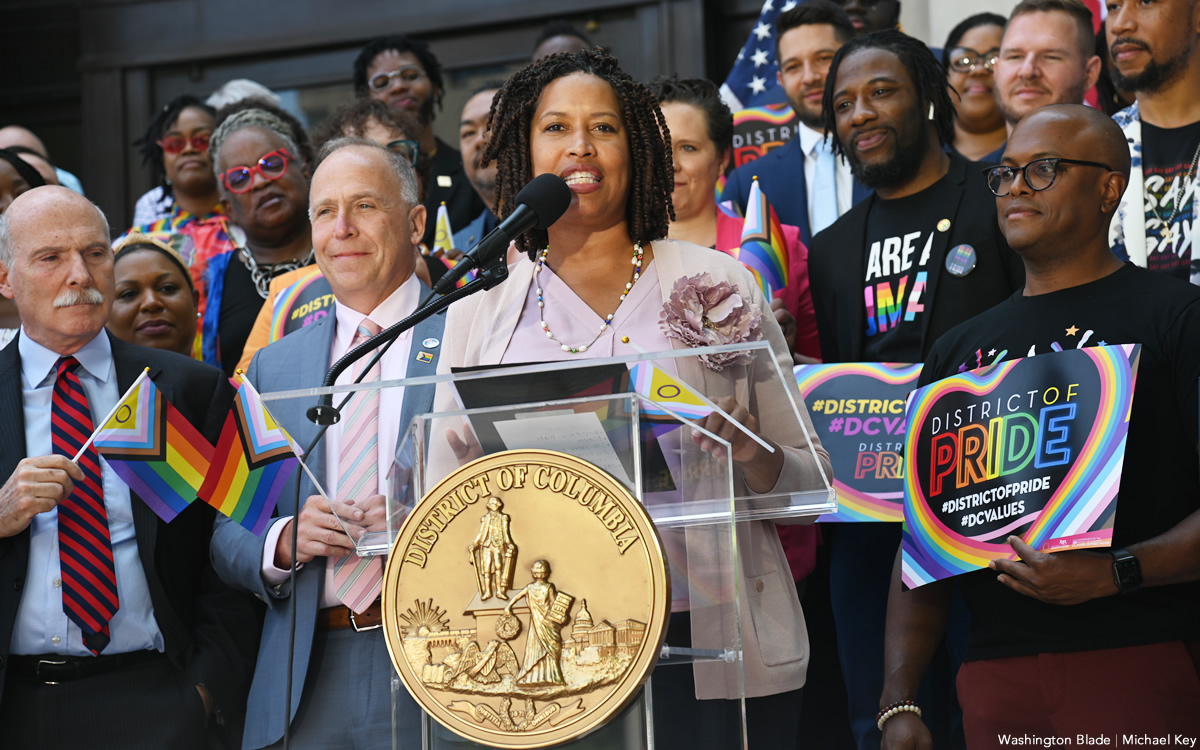
D.C. Mayor Muriel Bowser’s proposed fiscal year 2025 budget includes a request for $5.25 million in funding to support the June 2025 World Pride celebration, which D.C. will host, and which is expected to bring three million or more visitors to the city.
The mayor’s proposed budget, which she presented to the D.C. Council for approval earlier this month, also calls for a 7.6 percent increase in funding for the Mayor’s Office of LGBTQ Affairs, which amounts to an increase of $132,000 and would bring the office’s total funding to $1.7 million. The office, among other things, provides grants to local organizations that provide services to the LGBTQ community.
Among the other LGBTQ-related funding requests in the mayor’s proposed budget is a call to continue the annual funding of $600,000 to provide workforce development services for transgender and gender non-conforming city residents “experiencing homelessness and housing instability.” The budget proposal also calls for a separate allocation of $600,000 in new funding to support a new Advanced Technical Center at the Whitman-Walker Health’s Max Robinson Center in Ward 8.
Among the city agencies facing funding cuts under the mayor’s proposed budget is the HIV/AIDS, Hepatitis, Sexually Transmitted Disease, and Tuberculosis Administration, known as HAHSTA, which is an arm of the D.C. Department of Health. LGBTQ and AIDS activists have said HAHSTA plays an important role in the city’s HIV prevention and support services. Observers familiar with the agency have said it recently lost federal funding, which the city would have to decide whether to replace.
“We weren’t able to cover the loss of federal funds for HAHSTA with local funds,” Japer Bowles, director of the Mayor’s Office of LGBTQ Affairs, told the Washington Blade. “But we are working with partners to identify resources to fill those funding gaps,” Bowles said.
The total proposed budget of $21 billion that Bowser submitted to the D.C. Council includes about $500 million in proposed cuts in various city programs that the mayor said was needed to offset a projected $700 million loss in revenue due, among other things, to an end in pandemic era federal funding and commercial office vacancies also brought about by the post pandemic commercial property and office changes.
Bowser’s budget proposal also includes some tax increases limited to sales and business-related taxes, including an additional fee on hotel bookings to offset the expected revenue losses. The mayor said she chose not to propose an increase in income tax or property taxes.
Earlier this year, the D.C. LGBTQ+ Budget Coalition, which consists of several local LGBTQ advocacy organizations, submitted its own fiscal year 2025 budget proposal to both Bowser and the D.C. Council. In a 14-page letter the coalition outlined in detail a wide range of funding proposals, including housing support for LGBTQ youth and LGBTQ seniors; support for LGBTQ youth homeless services; workforce and employment services for transgender and gender non-conforming residents; and harm reduction centers to address the rise in drug overdose deaths.
Another one of the coalition’s proposals is $1.5 million in city funding for the completion of the D.C. Center for the LGBTQ Community’s new building, a former warehouse building in the city’s Shaw neighborhood that is undergoing a build out and renovation to accommodate the LGBTQ Center’s plans to move in later this year. The coalition’s budget proposal also calls for an additional $300,000 in “recurring” city funding for the LGBTQ Center in subsequent years “to support ongoing operational costs and programmatic initiatives.”
Bowles noted that Bowser authorized and approved a $1 million grant for the LGBTQ Center’s new building last year but was unable to provide additional funding requested by the budget coalition for the LGBTQ Center for fiscal year 2025.
“We’re still in this with them,” Bowles said. “We’re still looking and working with them to identify funding.”
The total amount of funding that the LGBTQ+ Budget Coalition listed in its letter to the mayor and Council associated with its requests for specific LGBTQ programs comes to $43.1 million.
Heidi Ellis, who serves as coordinator of the coalition, said the coalition succeeded in getting some of its proposals included in the mayor’s budget but couldn’t immediately provide specific amounts.
“There are a couple of areas I would argue we had wins,” Ellis told the Blade. “We were able to maintain funding across different housing services, specifically around youth services that affect folks like SMYAL and Wanda Alston.” She was referring to the LGBTQ youth services group SMYAL and the LGBTQ organization Wanda Alston Foundation, which provides housing for homeless LGBTQ youth.
“We were also able to secure funding for the transgender, gender non-conforming workforce program,” she said. “We also had funding for migrant services that we’ve been advocating for and some wins on language access,” said Ellis, referring to programs assisting LGBTQ people and others who are immigrants and aren’t fluent in speaking English.
Ellis said that although the coalition’s letter sent to the mayor and Council had funding proposals that totaled $43.1 million, she said the coalition used those numbers as examples for programs and policies that it believes would be highly beneficial to those in the LGBTQ community in need.
“I would say to distill it down to just we ask for $43 million or whatever, that’s not an accurate picture of what we’re asking for,” she said. “We’re asking for major investments around a few areas – housing, healthcare, language access. And for capital investments to make sure the D.C. Center can open,” she said. “It’s not like a narrative about the dollar amounts. It’s more like where we’re trying to go.”
The Blade couldn’t’ immediately determine how much of the coalition’s funding proposals are included in the Bowser budget. The mayor’s press secretary, Daniel Gleick, told the Blade in an email that those funding levels may not have been determined by city agencies.
“As for specific funding levels for programs that may impact the LGBTQ community, such as individual health programs through the Department of Health, it is too soon in the budget process to determine potential adjustments on individual programs run though city agencies,” Gleick said.
But Bowles said several of the programs funded in the mayor’s budget proposal that are not LGBTQ specific will be supportive of LGBTQ programs. Among them, he said, is the budget’s proposal for an increase of $350,000 in funding for senior villages operated by local nonprofit organizations that help support seniors. Asked if that type of program could help LGBTQ seniors, Bowles said, “Absolutely – that’s definitely a vehicle for LGBTQ senior services.”
He said among the programs the increased funding for the mayor’s LGBTQ Affairs office will support is its ongoing cultural competency training for D.C. government employees. He said he and other office staff members conduct the trainings about LGBTQ-related issues at city departments and agencies.
Bowser herself suggested during an April 19 press conference that local businesses, including LGBTQ businesses and organizations, could benefit from a newly launched city “Pop-Up Permit Program” that greatly shortens the time it takes to open a business in vacant storefront buildings in the downtown area.
Bowser and Nina Albert, D.C. Deputy Mayor for Planning and Economic Development, suggested the new expedited city program for approving permits to open shops and small businesses in vacant storefront spaces could come into play next year when D.C. hosts World Pride, one of the word’s largest LGBTQ events.
“While we know that all special events are important, there is an especially big one coming to Washington, D.C. next year,” Bowser said at the press conference. “And to that point, we proposed a $5.25 million investment to support World Pride 2025,” she said, adding, “It’s going to be pretty great. And so, we’re already thinking about how we can include D.C. entrepreneurs, how we’re going to include artists, how we’re going to celebrate across all eight wards of our city as well,” she said.
Among those attending the press conference were officials of D.C.’s Capital Pride Alliance, which will play a lead role in organizing World Pride 2025 events.
Maryland
Health care for Marylanders with HIV is facing huge cuts this summer
Providers poised to lose three-quarters of funding
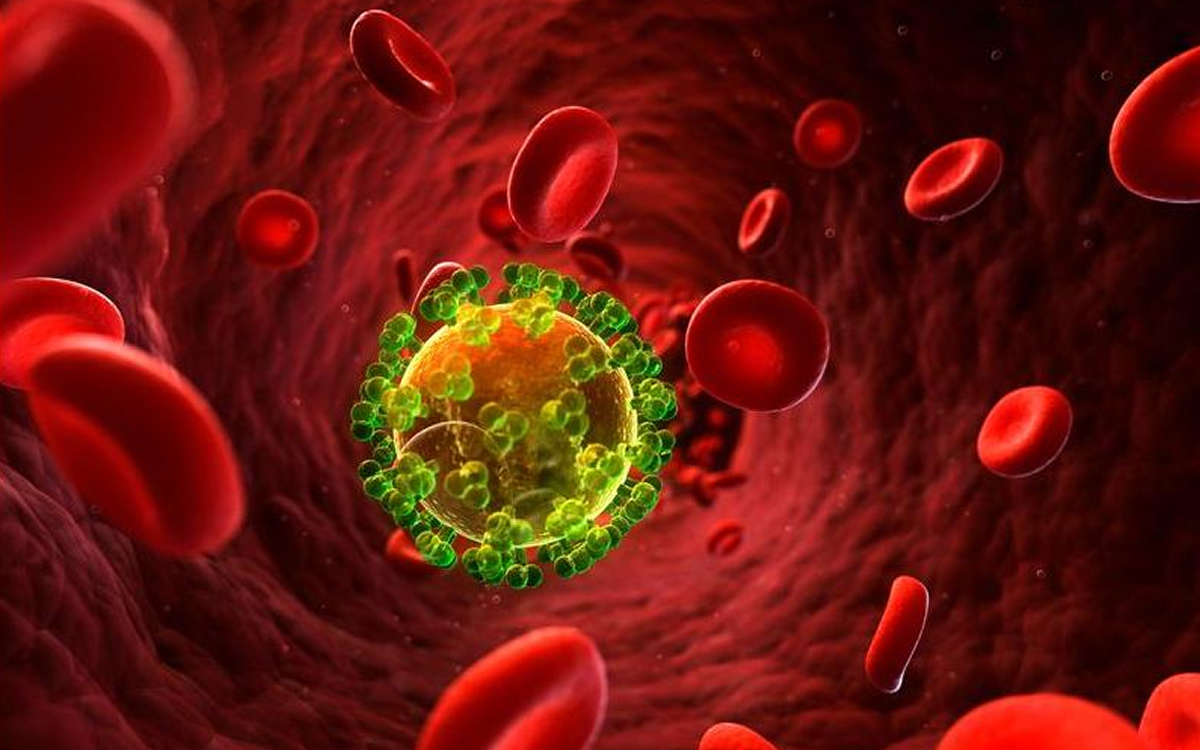
BY MEREDITH COHN | By the end of June, health care providers in Maryland will lose nearly three-quarters of the funding they use to find and treat thousands of people with HIV.
Advocates and providers say they had been warned there would be less money by the Maryland Department of Health, but were stunned at the size of the drop — from about $17.9 million this fiscal year to $5.3 million the next. The deep cuts are less than three months away.
The rest of this article can be read on the Baltimore Banner’s website.
-

 State Department2 days ago
State Department2 days agoState Department releases annual human rights report
-

 Maryland4 days ago
Maryland4 days agoJoe Vogel campaign holds ‘Big Gay Canvass Kickoff’
-

 Politics3 days ago
Politics3 days agoSmithsonian staff concerned about future of LGBTQ programming amid GOP scrutiny
-

 The White House1 day ago
The White House1 day agoWhite House debuts action plan targeting pollutants in drinking water

